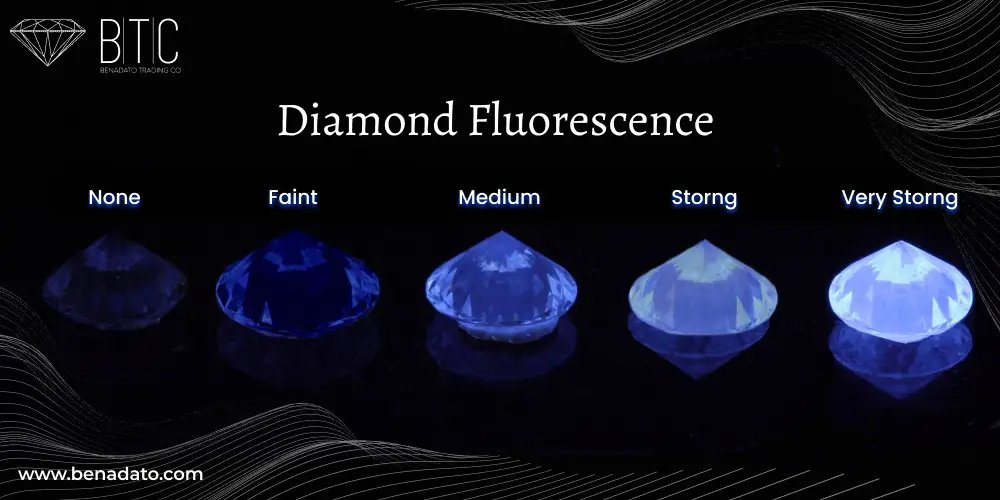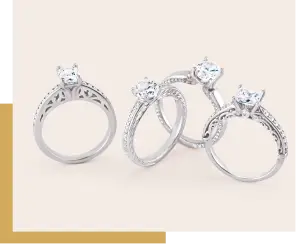
Most of us have paid attention to 4C’s of any diamond while purchasing or selling, but might have neglected a diamond’s fluorescence, haven’t we? On hearing diamond fluorescence, the first question that arises is, what is diamond fluorescence?
Some diamonds fluoresce(glow) when exposed to UV rays, for example: in front of the sunlight or fluorescent lamps. They emit a bluish light most often, and yellow or orange light in a rare case. This happens if boron, aluminum, or nitrogen is present in that particular land where crystallization processes.
After getting a fair idea about what is diamond fluorescence, you might have different questions like:
Do all diamonds fluoresce?
Is diamond fluorescence good or bad?
How does diamond fluorescence affect the color grade?
What does fluorescence mean in a diamond?
How does diamond fluorescence affect pricing,?
What are pros and cons of diamond fluorescence?
Can someone differentiate between fluorescent diamond and non-fluorescent diamond?
Let’s get an answer to each.
No, only 25 to 35 percent of diamonds have a fluorescence shine to them.
Sometimes the tiny amount of impurities present in a diamond can cause them to emit a glow, which means it is bad while sometimes glowing diamonds are ravishingly outstanding, which means it is good. So still, the question is diamond fluorescence good or bad remains the same as it depends on the viewer’s perspective that they might or might not like it.
It can improve the color of a diamond or make it look hazy, a slight presence of fluorescence makes diamonds look whiter, and more presence makes a diamond look cloudy. Cloudiness is more prevalent in higher color grades, so it’s best to avoid strong and medium fluorescent diamonds in D, E, and F color grade diamonds.
The effect of faint fluorescence is negligent, but a strong blue fluorescence can make a diamond’s color look better by two shades than the original one.
The Gemological Institute of America (GIA) does not consider fluorescence as important as cut, clarity, color, & carat, yet it grades diamond as per their fluorescence on a scale of very strong, strong, medium, faint, and none.
Did you know the most basic color of fluorescence is blue (95%), followed by yellow? The other colors of fluorescence are known to be extremely rare. When a diamond fluoresces blue it has an inclination to appear whiter in color than its real body color, this makes the diamond appear higher in color quality than it actually is. But, if the diamond fluoresces yellow in ultraviolet light, the diamond will appear lower in color, harming the appearance. So, fluorescence in a diamond changes the appearance, pricing, and the tendency to sparkle.
Strong fluorescent diamond prices are ordinarily down than the non-fluorescent diamonds. A higher color grade of non-fluorescent diamonds ranging from D to H is ten to thirty percent higher than ones emitting strong blue fluorescence. However, a lower color grade of non-fluorescent diamonds ranging from I to N is five percent lower than ones emitting strong blue fluorescence.
Pros: One of the biggest advantages of buying a fluorescent diamond is to get them at a lower price. For example, most colorless diamonds (D-F) with fluorescence sell at a fifteen to thirty percent discount. For near-transparent diamonds in the I-K color range, fluorescence is actually a charming attribute because the blue hue helps cancel out yellowish hues in conditions like sunlight.
Cons: Fluorescence does cause diamonds to look cloudy and milky, so before buying any fluorescent diamond think twice.
Yes, colored diamonds are graded for fluorescence like colorless stones. Unlike white diamonds, though, the majority of fancy colored diamonds look better with none or faint fluorescence grades. You can presume how both blue and yellow fluorescence could dilute or deteriorate the color quality of a fancy-colored diamond
Yes, but if a person looks at a diamond from upside down, then fluorescence might not be visible, and if the same is viewed from the right side up, then a normal knowledgeable person might spot it out.
Diamonds are always alluring, it is a personal choice to either go for fluorescent diamonds or not because, at times, fluorescence tends diamonds to look milky, cloudy, hazy, or grayish, and at times it enhances the color. If you want to go cost-effective, then this might be the best option, but at the same time, the resale-value of a fluorescent diamond will be lesser. Do you want to get relieved of any milky diamonds? Trust us for the best possible value of your old diamond.
Get in touch with us to sell any of your diamond pieces for the best value.
